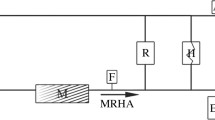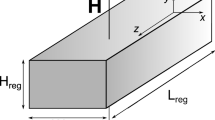The article addressed the heat exchange efficiency of an antifreeze flow, used as the working substance in a refrigeration system and filled with a magnetostrictive intermetallic alloy. A dynamic two-dimensional gradient magnetic field was employed as a propulsion source for the magnetostrictive coolant. The regulation and control of the volume flow rate of the coolant were achieved by inducing the dynamic magnetic field, which influenced the orientation and size of the scale-shaped particles dispersed within the coolant. Replacing conventional pumps with magnetic field-based propulsion systems for the circulation of antifreeze in heat-exchange systems offers a reduction in energy consumption in technological systems.


Similar content being viewed by others
References
M. L. Galkin, “ Optimization of thermodynamic characteristics of a magnetorheological coolant” [in Russian], Khim. Neftegas. Mashin., No. 9, 7–8 (2021).
A. A. Lyutoev and Yu. G. Smirnov, “ Development of a technological scheme for wastewater treatment from oil pollution using magnetic nanoparticles” [in Russian], Neftegaz. Delo: Elektr. Nauchn. Zh., No. 4 (2013).
E. I. Vatutin, S. Yu. Chevychelov, A. A. Rodionov, and N. M. Ignatenko, “ Modeling results for the process of generating elastic waves by an alternating magnetic field in magnetically ordered composites” [in Russian], Sb. Nauchn. Tr. “Welding and Related Technologies in Mechanical Engineering and Electronics” (2002).
L. K. Dereza and B. S. Tul’chinsky, Pat. RU 328153 [in Russian] (1972).
G. Otter al., Pat. RU 2414764 [in Russian] (2011).
M. L. Galkin and L. S. Genel’, Pat. RU 2624113 [in Russian] (2017).
M. L. Galkin and L. S. Genel’, Pat. RU 2644900 [in Russian] (2018).
Handbook of Chemist 21. Magnetostrictive Effect; https://www.chem21.info/info/392469/?y sclid=la3rc883x7218803212. Accessed November 8, 2022.
J. S. Kumar, P. S. Paul, G. Raghunathan, et al., “A review of challenges and solutions in the preparation and use of magnetorheological fluids,” Int. J. Mech. Mater. Eng., 13 (2019).
Author information
Authors and Affiliations
Corresponding author
Additional information
Translated from Khimicheskoe i Neftegazovoe Mashinostroenie, Vol. 58, No. 11, pp. 46–48, November, 2022
Rights and permissions
Springer Nature or its licensor (e.g. a society or other partner) holds exclusive rights to this article under a publishing agreement with the author(s) or other rightsholder(s); author self-archiving of the accepted manuscript version of this article is solely governed by the terms of such publishing agreement and applicable law.
About this article
Cite this article
Galkin, M.L. Magnetostrictive Antifreeze. Chem Petrol Eng 58, 980–985 (2023). https://doi.org/10.1007/s10556-023-01189-2
Published:
Issue Date:
DOI: https://doi.org/10.1007/s10556-023-01189-2




